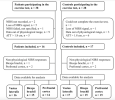Muscle and cerebral oxygenation during exercise in fibromyalgia: a near-infrared spectroscopy study
Taneli Lehto, Teemu Zetterman, Dominique Gagnon, Ritva Markkula, Jari Arokoski, Eija Kalso & Juha E. Peltonen
[Line breaks added]
Purpose
We studied muscle and brain oxygenation during submaximal and peak exercise in patients with fibromyalgia (FM), a condition characterized by pain and fatigue, compared with age-matched healthy controls (CON).
Methods
The participants (FM, n = 16; CON, n = 17) undertook a step incremental cycle spiroergometry until exhaustion. Changes in oxyhemoglobin (O2Hb), deoxyhemoglobin (HHb), total hemoglobin (tHB), and tissue saturation index (TSI%) using near-infrared spectroscopy were assessed in the vastus lateralis (leg) and biceps brachii (arm) muscles as well as the brain prefrontal cortex. Vastus lateralis blood flow (Q̇VL) was calculated from whole-body oxygen consumption (V̇O2) and HHb values. We analyzed between-group differences at absolute workloads and relative to V̇O2peak.
Results
No significant between-group differences emerged in leg or arm oxygenation.
Q̇VL was lower in FM at 50% (0.066 [0.022] vs. 0.080 [0.028] a.u.), 75% (0.082 [0.020] vs. 0.106 [0.039] a.u.), and 100% (0.091 [0.036] vs. 0.111 [0.041] a.u.) of V̇O2peak, but similar at submaximal absolute workloads.
Cerebral HHb values were higher in FM at 75 (1.09 [2.23] vs. −0.18 [1.38] μM) and 100 W (2.20 [2.96] vs. 0.06 [1.92] μM) but not at relative workloads.
Cerebral TSI%, O2Hb and tHb were not significantly different between groups.
Conclusion
Leg oxygenation or peak exercise cerebral deoxygenation in FM do not differ from controls. Q̇VL was lower at peak exercise in FM. These results present evidence that exercise intolerance in FM may rely on other mechanisms than muscle oxygenation.
Trial registration ClinicalTrials.gov, NCT03300635. Registered 3 October 2017—retrospectively registered. https://clinicaltrials.gov/ct2/show/NCT03300635.
Web | PDF | European Journal of Applied Physiology | Open Access
Taneli Lehto, Teemu Zetterman, Dominique Gagnon, Ritva Markkula, Jari Arokoski, Eija Kalso & Juha E. Peltonen
[Line breaks added]
Purpose
We studied muscle and brain oxygenation during submaximal and peak exercise in patients with fibromyalgia (FM), a condition characterized by pain and fatigue, compared with age-matched healthy controls (CON).
Methods
The participants (FM, n = 16; CON, n = 17) undertook a step incremental cycle spiroergometry until exhaustion. Changes in oxyhemoglobin (O2Hb), deoxyhemoglobin (HHb), total hemoglobin (tHB), and tissue saturation index (TSI%) using near-infrared spectroscopy were assessed in the vastus lateralis (leg) and biceps brachii (arm) muscles as well as the brain prefrontal cortex. Vastus lateralis blood flow (Q̇VL) was calculated from whole-body oxygen consumption (V̇O2) and HHb values. We analyzed between-group differences at absolute workloads and relative to V̇O2peak.
Results
No significant between-group differences emerged in leg or arm oxygenation.
Q̇VL was lower in FM at 50% (0.066 [0.022] vs. 0.080 [0.028] a.u.), 75% (0.082 [0.020] vs. 0.106 [0.039] a.u.), and 100% (0.091 [0.036] vs. 0.111 [0.041] a.u.) of V̇O2peak, but similar at submaximal absolute workloads.
Cerebral HHb values were higher in FM at 75 (1.09 [2.23] vs. −0.18 [1.38] μM) and 100 W (2.20 [2.96] vs. 0.06 [1.92] μM) but not at relative workloads.
Cerebral TSI%, O2Hb and tHb were not significantly different between groups.
Conclusion
Leg oxygenation or peak exercise cerebral deoxygenation in FM do not differ from controls. Q̇VL was lower at peak exercise in FM. These results present evidence that exercise intolerance in FM may rely on other mechanisms than muscle oxygenation.
Trial registration ClinicalTrials.gov, NCT03300635. Registered 3 October 2017—retrospectively registered. https://clinicaltrials.gov/ct2/show/NCT03300635.
Web | PDF | European Journal of Applied Physiology | Open Access
Last edited:

